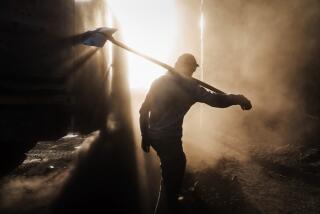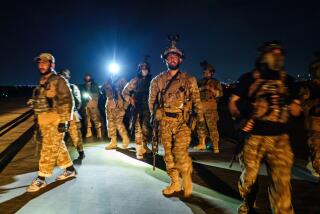Fighters Hunt Former Ally
- Share via
TORA BORA, Afghanistan — In the cold, thin mountain air, the soldiers stood on a rocky ridge and blasted the opposite peak. The tank turret roared, and the men pumped their fists. They smelled the gunpowder, saw the smoke and knew their hunt was creeping forward.
They were stalking a man who had been one of their own.
Osama bin Laden once moved among these soldiers, first coming to the White Mountains in the 1980s with other idealistic Muslims eager to snatch Afghanistan from the grip of Soviet control. Now, some officials believe, the infamous fugitive is cornered in Tora Bora with flocks of his underlings, most of them foreigners.
“This was the center of our jihad [holy war],” said Mohammed Ibrahim Babrak, who 13 years ago fought the Soviets from the caves of Tora Bora. The 32-year-old glared into the hills Wednesday as his squadron opened fire. “Those people don’t belong there.”
It’s been more than a decade since the United States gave Afghan forces the money to carve a military base into the hillsides of this outback mountain range in eastern Afghanistan. The idea was to create a fortress strong enough to withstand Soviet troops--and it worked.
Now that very network of caves and bunkers is reportedly harboring hundreds of America’s newest, and perhaps most vehement, foes.
Military commanders here say as many as 2,000 Al Qaeda fugitives are in the caves. They can’t move south: Autumn snows clog those mountain passages. And Babrak and his anti-Taliban warriors are pounding their way down from the north. The foreign fighters are trapped.
“We are trying our best to get them alive,” front-line commander Alim Shah said. “They’ve been surrounded by us. But they are resisting.”
And so Shah’s forces are plowing in on foot. They won’t stop, they say, until they’ve flushed out every Al Qaeda fighter. They don’t expect it to take long--some commanders say a few days; others, a few weeks.
The stakes are high. Commanders here are gunning for the $25-million bounty the U.S. government is offering for Bin Laden’s capture--and they make no secret of this mercenary streak.
“The United States has to give the money,” said Haji Mohammed Zaman, the commander for northeastern Afghan opposition forces. “Twenty-five million. They promised it, and we will remind them.”
But first, they have to catch the elusive Bin Laden--who may be nowhere near Tora Bora. Mystery hangs on basic details of Bin Laden’s whereabouts. It isn’t known whether he’s still in Afghanistan or, for that matter, whether he’s still alive.
Bin Laden was sighted in Tora Bora five days ago, said provincial security chief Hazrat Ali. Since then, as far as opposition officials here can tell, he has disappeared. But they believe that Bin Laden’s lieutenant, Ayman Zawahiri, was killed in the Tora Bora region this week. As Bin Laden’s most important aide and his personal doctor, the Egyptian rarely strayed far from the Saudi terrorist.
Over the course of Bin Laden’s tumultuous career, the White Mountains have been a backdrop for times of formation and crisis. A young Bin Laden first saw these dusty hills during the U.S.-funded war against the Soviets. In those years, he swung back and forth between Pakistan and Afghanistan. In the process, the idealistic but pampered Saudi construction heir became an Islamic fundamentalist.
A decade later, when Sudan kicked Bin Laden out of the country and he had nowhere to go, he turned to Tora Bora for sanctuary. He flew a chartered jet to Jalalabad in May 1996 and lived for a time in the nearby caves. Later that year, he moved his headquarters to Kandahar, the Taliban regime’s spiritual capital in southern Afghanistan, but maintained a family and a house in Jalalabad.
He continued his journeys to Tora Bora’s swath of towering peaks and plunging valleys. The only road to the caves from Jalalabad is an arduous, jouncing trail through fields of dust and crumbling mud villages. Ancient terrace farms cling to the mountainsides in defiance of erosion.
Snowfall Helps Cut Escape Routes
In this vast landscape of rock and sky, water is still carried by donkey and on the heads of women. The mountains stretch to the horizon, varying only in color: Brown gives way to blue, and, beyond that, the highest mountains gleam with snow.
The snow fell before dawn Monday, sealing off the mountain passes eastward into Pakistan and southward to the rest of Afghanistan. The same day, Afghan forces seized the road between Tora Bora and Jalalabad, choking off supply lines for the Al Qaeda fugitives. By nightfall the next day, the anti-Taliban fighters had taken control of the smaller trails linking the caves to the nearby villages. And on Wednesday, they fanned out and scrambled up the canyons to close in on Tora Bora from three sides.
Tora Bora’s isolation has long made it an ideal hide-out: A lone valley stretches into the encampment. It’s impossible to reach the caves by vehicle. And the height allows inhabitants to keep a watchful eye on anybody who might get near the cave entrances.
The ground near those entrances is thick with oaks and pine, making them almost impossible to spot. The trees fueled a healthy timber industry until the Taliban shut the logging operations down.
Inside, the chambers are outfitted with heat, ventilation and electricity--the place has enjoyed some upgrades since the United States’ burst of anti-Soviet industrialism. The caves are huge--large enough to drive a truck inside--and they are said to be eerie: Tora Bora means “black dust,” and some of the walls are reportedly made of glistening black rock.
It is to these underground hide-outs that the Al Qaeda holdouts may try to lure the attackers. Anti-Taliban commanders said they had intercepted wireless conversations in which an Al Qaeda commander warned his soldiers against attacking the invaders.
“They said, ‘Don’t fire on them; let them come near,’ ” commander Shorab Khan said. “ ‘Then you can surround them.’ ”
Years ago, the former Soviet Union pummeled the caves with nearly everything in its arsenal, and still it couldn’t seize them. Now the men who once dug themselves into the mountains stand in the foothills and fire into their old home, knowing full well its impenetrability.
‘It’s a Difficult War in the Mountains’
Many of them have been waging war for years, first against the Soviets and later against the Taliban. They’ve already seized a few caverns, the commanders said, and have driven the Al Qaeda fighters higher and deeper into the mountains.
“It’s a difficult war in the mountains,” Khan said. “It’s very hard to go forward.”
When U.S. warplanes drop their bombs to help Khan and his men, it’s the smoke the soldiers see first--great billows rising from the canyons. A few moments later, the roar of an explosion rattles across the hills.
Not far from the anti-Taliban lines, farmers were perched on rocks, bemused as they watched another war pound over these old hills. They exchanged grins when the smoke rose from the valleys.
They have seen the fighting before.
More to Read
Sign up for Essential California
The most important California stories and recommendations in your inbox every morning.
You may occasionally receive promotional content from the Los Angeles Times.










